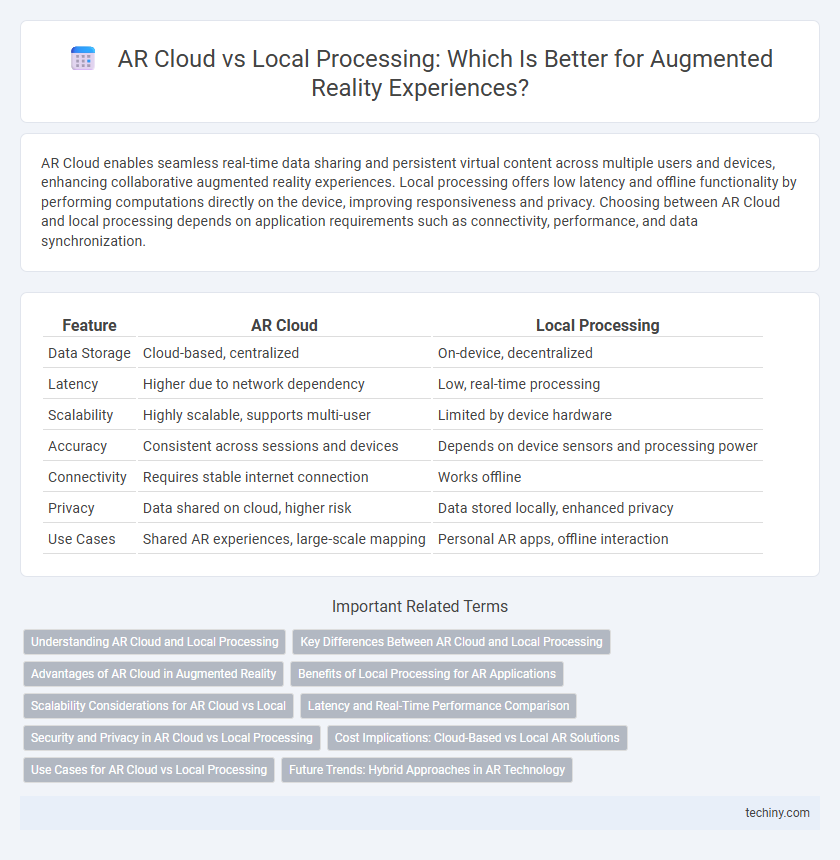AR Cloud enables seamless real-time data sharing and persistent virtual content across multiple users and devices, enhancing collaborative augmented reality experiences. Local processing offers low latency and offline functionality by performing computations directly on the device, improving responsiveness and privacy. Choosing between AR Cloud and local processing depends on application requirements such as connectivity, performance, and data synchronization.
Table of Comparison
| Feature | AR Cloud | Local Processing |
|---|---|---|
| Data Storage | Cloud-based, centralized | On-device, decentralized |
| Latency | Higher due to network dependency | Low, real-time processing |
| Scalability | Highly scalable, supports multi-user | Limited by device hardware |
| Accuracy | Consistent across sessions and devices | Depends on device sensors and processing power |
| Connectivity | Requires stable internet connection | Works offline |
| Privacy | Data shared on cloud, higher risk | Data stored locally, enhanced privacy |
| Use Cases | Shared AR experiences, large-scale mapping | Personal AR apps, offline interaction |
Understanding AR Cloud and Local Processing
AR Cloud enables real-time, persistent mapping and environmental understanding by storing spatial data in the cloud, allowing multiple devices to access shared virtual content with high accuracy. Local processing handles sensor data directly on the device, ensuring low latency and privacy by performing real-time tracking and rendering without network dependence. Combining AR Cloud with local processing optimizes performance, scalability, and user experience in augmented reality applications.
Key Differences Between AR Cloud and Local Processing
AR Cloud enables real-time synchronization and shared experiences across multiple devices by offloading data storage and processing to remote servers, enhancing scalability and collaboration. Local processing handles data directly on the device, ensuring lower latency and greater privacy by minimizing reliance on internet connectivity. The key differences lie in AR Cloud's ability to support persistent, multi-user environments versus local processing's focus on immediate responsiveness and offline functionality.
Advantages of AR Cloud in Augmented Reality
The AR Cloud offers real-time, persistent spatial mapping that enables seamless multi-user experiences and accurate environmental understanding across devices. Cloud-based processing provides scalable computational power beyond the limitations of local hardware, facilitating complex AR applications such as large-scale object recognition and dynamic content updates. This centralized infrastructure enhances data synchronization, reduces latency, and supports continuous improvement through shared learning models, driving more immersive and context-aware augmented reality experiences.
Benefits of Local Processing for AR Applications
Local processing in augmented reality applications enhances responsiveness by minimizing latency, ensuring real-time interaction and seamless user experiences. It reduces dependency on network connectivity, providing consistent performance even in areas with limited or unstable internet access. Moreover, local processing improves data privacy and security by keeping sensitive information on-device rather than transmitting it to external servers.
Scalability Considerations for AR Cloud vs Local
AR Cloud leverages centralized data storage and real-time synchronization across devices, enabling scalable deployment of shared augmented reality experiences across vast geographic areas and diverse user bases. Local processing relies on device-specific computation, limiting scalability due to hardware constraints and isolated data silos that hinder collaborative interactions and expansive content updates. Scalability in AR Cloud is enhanced by cloud infrastructure elasticity, while local processing scalability is constrained by the device's processing power and storage capacity.
Latency and Real-Time Performance Comparison
AR Cloud offers lower latency and superior real-time performance by processing data on powerful remote servers, enabling seamless synchronization across multiple devices. In contrast, local processing reduces dependence on network connectivity but often faces higher latency and limited computational resources, which can hinder complex AR interactions. For applications requiring instant responsiveness and multi-user collaboration, AR Cloud is the preferred approach, while local processing suits offline or latency-tolerant use cases.
Security and Privacy in AR Cloud vs Local Processing
AR Cloud offers centralized data storage and processing, enhancing collaborative experiences but raising concerns over potential data breaches and unauthorized access. Local processing ensures data remains on the user's device, significantly reducing exposure to external threats and improving privacy control. However, local processing may limit real-time data sharing and synchronization across multiple AR devices.
Cost Implications: Cloud-Based vs Local AR Solutions
Cloud-based AR solutions often incur higher ongoing costs due to server maintenance, data storage, and bandwidth usage, whereas local AR processing demands a larger initial investment in high-performance hardware but reduces recurring expenses. The scalability of AR cloud services allows businesses to pay based on usage, making it cost-efficient for varying workloads, while local processing offers lower latency and offline capabilities at the expense of hardware upgrades and maintenance. Companies must weigh the trade-offs between operational expenditures for cloud deployments and capital expenditures for local AR infrastructure to optimize their budget and performance needs.
Use Cases for AR Cloud vs Local Processing
AR Cloud enables seamless multi-user collaboration and persistent spatial mapping, making it ideal for large-scale urban planning, remote assistance, and shared gaming experiences. Local processing excels in latency-sensitive scenarios such as indoor navigation, real-time object recognition, and standalone AR applications on mobile devices. Combining AR Cloud with local processing enhances performance for mixed reality environments, balancing data synchronization with fast on-device computations.
Future Trends: Hybrid Approaches in AR Technology
Hybrid approaches in augmented reality technology combine AR Cloud and local processing to enhance performance and scalability. By leveraging cloud-based data synchronization alongside real-time local computation, these systems enable low latency interactions and enriched persistent experiences. Future trends indicate increasing adoption of AI-driven edge computing to optimize resource usage while maintaining seamless AR experiences across diverse environments.
AR Cloud vs Local Processing Infographic

 techiny.com
techiny.com